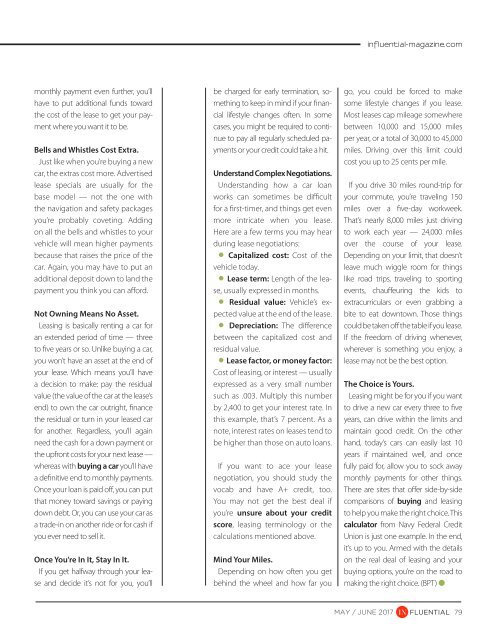InFluential_Magazine_May_June_2017
You also want an ePaper? Increase the reach of your titles
YUMPU automatically turns print PDFs into web optimized ePapers that Google loves.
influential-magazine.com<br />
monthly payment even further, you’ll<br />
have to put additional funds toward<br />
the cost of the lease to get your payment<br />
where you want it to be.<br />
Bells and Whistles Cost Extra.<br />
Just like when you’re buying a new<br />
car, the extras cost more. Advertised<br />
lease specials are usually for the<br />
base model — not the one with<br />
the navigation and safety packages<br />
you’re probably coveting. Adding<br />
on all the bells and whistles to your<br />
vehicle will mean higher payments<br />
because that raises the price of the<br />
car. Again, you may have to put an<br />
additional deposit down to land the<br />
payment you think you can afford.<br />
Not Owning Means No Asset.<br />
Leasing is basically renting a car for<br />
an extended period of time — three<br />
to five years or so. Unlike buying a car,<br />
you won’t have an asset at the end of<br />
your lease. Which means you’ll have<br />
a decision to make: pay the residual<br />
value (the value of the car at the lease’s<br />
end) to own the car outright, finance<br />
the residual or turn in your leased car<br />
for another. Regardless, you’ll again<br />
need the cash for a down payment or<br />
the upfront costs for your next lease —<br />
whereas with buying a car you’ll have<br />
a definitive end to monthly payments.<br />
Once your loan is paid off, you can put<br />
that money toward savings or paying<br />
down debt. Or, you can use your car as<br />
a trade-in on another ride or for cash if<br />
you ever need to sell it.<br />
Once You’re In It, Stay In It.<br />
If you get halfway through your lease<br />
and decide it’s not for you, you’ll<br />
be charged for early termination, something<br />
to keep in mind if your financial<br />
lifestyle changes often. In some<br />
cases, you might be required to continue<br />
to pay all regularly scheduled payments<br />
or your credit could take a hit.<br />
Understand Complex Negotiations.<br />
Understanding how a car loan<br />
works can sometimes be difficult<br />
for a first-timer, and things get even<br />
more intricate when you lease.<br />
Here are a few terms you may hear<br />
during<br />
•<br />
lease negotiations:<br />
Capitalized cost: Cost of the<br />
vehicle<br />
•<br />
today.<br />
Lease term: Length of the lease,<br />
•<br />
usually expressed in months.<br />
Residual value: Vehicle’s expected<br />
•<br />
value at the end of the lease.<br />
Depreciation: The difference<br />
between the capitalized cost and<br />
residual<br />
•<br />
value.<br />
Lease factor, or money factor:<br />
Cost of leasing, or interest — usually<br />
expressed as a very small number<br />
such as .003. Multiply this number<br />
by 2,400 to get your interest rate. In<br />
this example, that’s 7 percent. As a<br />
note, interest rates on leases tend to<br />
be higher than those on auto loans.<br />
If you want to ace your lease<br />
negotiation, you should study the<br />
vocab and have A+ credit, too.<br />
You may not get the best deal if<br />
you’re unsure about your credit<br />
score, leasing terminology or the<br />
calculations mentioned above.<br />
Mind Your Miles.<br />
Depending on how often you get<br />
behind the wheel and how far you<br />
go, you could be forced to make<br />
some lifestyle changes if you lease.<br />
Most leases cap mileage somewhere<br />
between 10,000 and 15,000 miles<br />
per year, or a total of 30,000 to 45,000<br />
miles. Driving over this limit could<br />
cost you up to 25 cents per mile.<br />
If you drive 30 miles round-trip for<br />
your commute, you’re traveling 150<br />
miles over a five-day workweek.<br />
That’s nearly 8,000 miles just driving<br />
to work each year — 24,000 miles<br />
over the course of your lease.<br />
Depending on your limit, that doesn’t<br />
leave much wiggle room for things<br />
like road trips, traveling to sporting<br />
events, chauffeuring the kids to<br />
extracurriculars or even grabbing a<br />
bite to eat downtown. Those things<br />
could be taken off the table if you lease.<br />
If the freedom of driving whenever,<br />
wherever is something you enjoy, a<br />
lease may not be the best option.<br />
The Choice is Yours.<br />
Leasing might be for you if you want<br />
to drive a new car every three to five<br />
years, can drive within the limits and<br />
maintain good credit. On the other<br />
hand, today’s cars can easily last 10<br />
years if maintained well, and once<br />
fully paid for, allow you to sock away<br />
monthly payments for other things.<br />
There are sites that offer side-by-side<br />
comparisons of buying and leasing<br />
to help you make the right choice. This<br />
calculator from Navy Federal Credit<br />
Union is just one example. In the end,<br />
it’s up to you. Armed with the details<br />
on the real deal of leasing and your<br />
buying options, you’re on the road to<br />
making the right choice. (BPT) l<br />
MAY / JUNE <strong>2017</strong><br />
FLUENTIAL 79


















